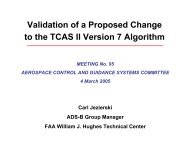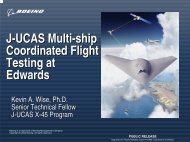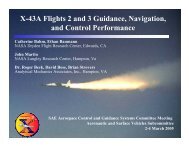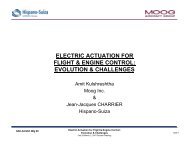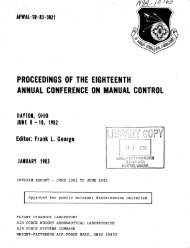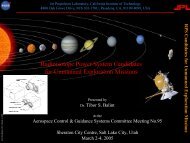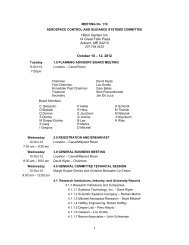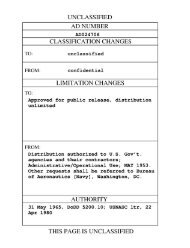Report of the Second Piloted Aircraft Flight Control System - Acgsc.org
Report of the Second Piloted Aircraft Flight Control System - Acgsc.org
Report of the Second Piloted Aircraft Flight Control System - Acgsc.org
You also want an ePaper? Increase the reach of your titles
YUMPU automatically turns print PDFs into web optimized ePapers that Google loves.
The high frequency attenuation is expressed by <strong>the</strong> relation <strong>of</strong> equation<br />
(19) . The cross-over frequency is defined by <strong>the</strong> intersection <strong>of</strong><br />
<strong>the</strong> low and high frequency asymptotes.<br />
Phase shift is represented by straight lines on semilogarithmic<br />
coordinates in figure 7. The slope <strong>of</strong> <strong>the</strong> low frequency line is defined<br />
by <strong>the</strong> slope <strong>of</strong> <strong>the</strong> first order system (equation (14)) at jd = 45O. The<br />
slope <strong>of</strong> <strong>the</strong> high frequency line is defined by <strong>the</strong> slope <strong>of</strong> <strong>the</strong> second order<br />
system (equation (20)) at $ = 90'. The low frequency phase shift line<br />
passes through # = 45' at <strong>the</strong> low frequency band break frequency ( fl) .<br />
The high frequency phase shift line is oriented by <strong>the</strong> cross-over frequency.<br />
In figure 7 <strong>the</strong> cross-over frequency is shown to occur after<br />
<strong>the</strong> low frequency phase shift line has reached <strong>the</strong> 90° limit. The orientation<br />
<strong>of</strong> <strong>the</strong> high frequency phase shift line for o<strong>the</strong>r relative<br />
locations <strong>of</strong> <strong>the</strong> cross-over frequency is shown in connection with <strong>the</strong><br />
experimental responses.<br />
Experimental responses. - Figure 8 shows <strong>the</strong> experimentally and analytically<br />
determined effect on <strong>the</strong> frequency response <strong>of</strong> <strong>the</strong> hydraulic<br />
servomotor <strong>of</strong> <strong>the</strong> parameters: load inertia and input amplitude.<br />
Figure 8(a) shows <strong>the</strong> effect <strong>of</strong> load inertia on <strong>the</strong> amplitude attenuation<br />
and on <strong>the</strong> phase shift. An increase in load inertia results in a<br />
reduction in <strong>the</strong> frequency at which <strong>the</strong> attenuation becomes rapid. In<br />
<strong>the</strong> analytical expression developed in this paper (summarized in fig. 7)<br />
this effect is evident in <strong>the</strong> increased value <strong>of</strong> E' with increasing<br />
load inertia and <strong>the</strong> consequent reduction in <strong>the</strong> values <strong>of</strong> f2 and f3.<br />
Figure 8(b) shows <strong>the</strong> effect <strong>of</strong> input amplitude on <strong>the</strong> frequency<br />
response. The increase in input amplitude is seen to have an effect similar<br />
to that <strong>of</strong> increasing load inertia. This effect is made evident in<br />
<strong>the</strong> analysis by equation (17).<br />
In both amplitude and phase shift <strong>the</strong> agreement between <strong>the</strong> measured<br />
responses and <strong>the</strong> analytical straight line approximations is in general<br />
well within <strong>the</strong> experimental accuracy. The slopes <strong>of</strong> <strong>the</strong> attenuation and<br />
phase data clearly demonstrate <strong>the</strong> first order characteristics <strong>of</strong> <strong>the</strong><br />
response in <strong>the</strong> low frequency band <strong>the</strong> <strong>the</strong> second-order characteristics<br />
<strong>of</strong>.<strong>the</strong> response in <strong>the</strong> high frequency band. The transition from first<br />
to second order characteristics at <strong>the</strong> calculated break frequency is<br />
quite pronojmced.<br />
APPLICATION TO DESIGlV<br />
Design Relations<br />
From equatiol23 (3) and (8) <strong>the</strong> following expressions for <strong>the</strong> piston<br />
area and <strong>the</strong> product <strong>of</strong> <strong>the</strong> feedback ratio and port xidth <strong>of</strong> a straight<br />
line servomotor can be derived:



